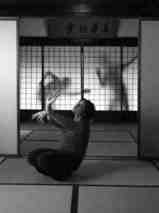| ||||||
《源氏物語》真正的書寫及完成時間至今仍無定論,學者專家從作者紫式部在西元1008年11月1日的日記中,發現其中記載這部作品在當時平安朝貴族間爭相傳閱的情形,就用這個時間算到2008年的11月1日,剛好一千年……
4月1日,愚人節。「選在這種日子出發,追櫻會成功嗎?」翻開一頁頁蓋滿戳記的護照,忍不住問自己。 進入登機室,笑容可掬的地勤送上一本小冊子,裡面是三種不同尺寸的便利貼,背面印著台北往返成田、關西機場的運航時間表,附上一張中、日文的小紙條,感謝 我們搭乘JAL日本航空4月1日從台灣飛往日本的首航,正式和已經飛行三十二年的日亞航說bye-bye。「這是愚人節的禮物嗎?」忍不住又問自己。 隔天站在京都真如堂前滿開到幾乎看不到枝葉的櫻花時,一顆心才獲得釋放,任春日香甜薰風將數年來不斷追逐的疲憊徐徐吹散,只想坐在樹下打個小盹,假裝一切 都沒發生過。但是2008年的京都,除了賞櫻狩楓之外,還有一件盛事,就是到處可以看到「《源氏物語》千年紀」的活動及海報,整個古都蒙上一層泛金的華麗 面紗。
這一千年是怎麼計算出來的?《源氏物語》真正的書寫及完成時間至今仍無定論,學者專家從作者紫式部在西元1008年11月1日的日記中,發現其中記載這部作品在當時平安朝貴族間爭相傳閱的情形,就用這個時間算到2008年的11月1日,剛好一千年。 《源氏物語》原本只是寫給後宮女眷看的「言情小說」,會變成男男女女爭相傳閱的暢銷書,原因不只一個,紫式部的文字功力了得,居功最大。她從小跟在詩人父 親身旁讀書,尤其鍾愛漢籍《史記》和白居易的詩文,也因為這項專長,三十歲不到就守寡的她,在西元1005年被召喚入宮,為一條天皇的中宮「彰子」解說 《日本書紀》和白居易的詩,在後宮侍讀一段日子,開始寫《源氏物語》。 林永福教授另有一說,在《源氏物語的女性》書中寫道:「紫式部可能在她丈夫藤原宣孝去世那年(1001年)就開始動筆,並完成部分的《源氏物語》,因此聲名大噪,才被彰子邀入宮中,繼續撰寫《源氏物語》。」 茂呂美耶在《物語日本》一篇談「隨筆文字之祖」的文章中,就把紫式部和《枕草子》的作者清少納言,平安時代(西元794~1192年)兩大才媛互相比較。 清少納言離婚後二十八歲入宮伺候一條天皇的中宮「定子」,聰明機智、溫柔明朗的個性,馬上變成宮廷「文藝沙龍」的紅牌要角。定子失寵病逝後,中宮換成彰 子,紫式部就取代清少納言的位置。紫式部曾在日記中批評清少納言的漢字文章。看起來茂呂美耶似乎比較欣賞清少納言的寬宏氣度。 後宮女官彼此競爭,不知是為自己還是為主子?當時的「紙」是非常非常稀有昂貴的物品,若非賞賜,一般人拿不到也負擔不起。所以還有一種說法是藤原為了幫助 自己的女兒彰子能夠受到天皇寵愛,找紫式部撰寫《源氏物語》,再由彰子說故事來吸引天皇上門求歡。後宮粉黛三千,比美麗永遠比不完,有「學養」的妃子更具 魅力!平安時代的「攝關政治」,大權掌握在攝政、關白這些天皇外戚手上,要實際掌握政權就要想辦法先讓女兒入宮,並生下皇子,再扶持外孫成為皇太子,下一 步就是幫助皇太子正式就位為皇上,藤原時代從西元858年到1016年,就是用這種方法掌握政權。 當時的貴族婚姻是「訪妻制」,女子婚後仍住在娘家,女婿不來,丈人、妻舅軟硬兼施,連哄帶騙也要設法逮人。如果以《源氏物語》全書中,長得貌不驚人,甚至 列為「醜女」的末摘花為例,源氏後來雖然看清她的長相,也識破她的琴藝、和歌皆不佳,中間甚至一度忘了她,但後來看到末摘花依然守在雜草叢生、連盜賊也過 門不入的荒廢舊居中,一心一意等待,大受感動,下定決心一輩子都要好好照顧她,兩年後真的將這位馬臉象鼻的癡心小姐迎入二條院享福。 還有一位「花散里」,即令源氏與她聚少離多,她永遠一如往昔,毫無怨恨之色,源氏最後也將她迎入改建後的二條院,和末摘花都安置在東院。但花散里是一位能 讓源氏信任的女子,源氏託花散里擔任自己兒子夕霧的監護人,從夕霧口中我們才知道:「這位繼母長得真是難看,但父親竟然連這樣的人也捨不得!」夕霧後來發 現父親喜歡的是花散里柔順可親的性情。過幾年源氏又將花散里移到「夏之御殿」,四周水晶花籬為垣,清涼泉水,濃蔭夏木,院內遍植夏花,排場不亞於最美的紫 之上夫人,源氏死後還將二條東院賞給花散里,花散里在夕霧的照顧下,安享晚年。 這兩位其貌不揚的女子,下場都比美女空蟬、夕顏、紫之上、朧月夜,還有第二代的大女公子、浮舟這對同父異母的苦情姊妹花幸運,由此推論《源氏物語》的背後,也許另有推手,就是希望女婿好好疼惜女兒的那位泰山大人。 在那樣的時代氛圍下,女人十分脆弱無奈,她們的一生幾乎都被命運的簾幕豢養在小小的格子門內,瘦弱、多病、蒼白、哀怨,彷彿皆是為了償還風流債而生,了卻 夙願而死。紫式部感慨「這個惡濁可欺的末世……總是越來越壞」,《源氏物語》由盛而衰的荒涼頹圮,比曹雪芹的《紅樓夢》早了七百年。
遠在另外一頭琵琶湖畔的「《源氏物語》千年紀in湖都大津」也不落人後。石山寺號稱《源氏物語》發祥地,這裡特別設置「源氏夢回廊」,一整年都可以在石山 寺不同殿堂中,參觀和紫式部有關的展覽。石山寺地處偏遠,要搭京坂石山坂本線出城,石山寺只從早上九點開放到下午四點半,扣掉爬山的時間,需提早出發,最 好預留一整天的時間慢慢遊賞。如果錯過上半年的《源氏物語》日本刺繡展和染色史家吉剛幸雄衣裳展;下半年還有「紫氏部千年戀館」,展示吉永小百合飾演紫氏 部,或天海祐希飾演光源氏的戲服。10月12日以後,還有十二單衣試穿體驗,注意先確定時間,而且每天午前、午後只有各四個名額。 過去比較常在京都玩耍,弄不清楚遠在琵琶湖畔的石山寺,為何和《源氏物語》也有關係,後來看到一份地圖,才發現若以京都為中心,右至石山寺,上至北山,左 至嵯峨野清涼寺,右下至宇治,左下至明石、須磨,足跡跨越京都府、大阪府、奈良縣、兵庫縣和滋賀縣,全都是小說的場景,難怪全體總動員。 京都府的活動更多,大多以博物館、圖書館為主軸,包括講座、文化展、能面展、茶陶器展、繪卷展、室內樂、朗讀、舞蹈劇,還有將《源氏物語》比較西歐宮廷文學中的王妃之戀演講等,整個委員會從2007年1月30日就成立,運作至今。 這樣大費周章,是否已將《源氏物語》的輪廊描繪得更加清晰?我並未刻意參與這場千年盛會,只因無法連續訂到旅館,被迫暫離京都兩天,卻意外發現石山寺和另 一座與藤原道長息息相關的三井寺,一站比一站盛開的櫻花,讓我幾乎處於幸福滿溢的亢奮狀態。紫式部認為物語有「瞭解世相」的功能,她寫《源氏物語》,寫的 是真實的人生,看書中四百多個人物進進出出,為愛煩惱,為情痛苦,借景抒情,借物抒懷,最後除了遁入空門,幾乎難得善終,難怪紫式部喜歡白居易,《源氏物 語》是她筆下一卷日本平安王朝的〈長恨歌〉。 這是個幸運的愚人節,花開得不能再好,雨下得不能再多,一千年後是否還有癡人追櫻?逐字逐句探索紫式部筆下千迴百轉的愛恨情仇? |
源氏物語:源氏千年紀、最古の「梅枝巻」確認 甲南女子大、鎌倉中期の写本
甲南女子大(神戸市)は29日、所蔵する源氏物語54帖(じょう)の一つ「梅枝巻(うめがえのまき)」の「別本」系統の写本が、鎌倉時代中期のも のと確認されたと発表した。梅枝巻としては、東京国立博物館所蔵の写本と同時期で、現存するものでは最古。他の写本にはない表現があり、紫式部が書いた原 文を知る手がかりになる可能性もあるという。
1973年に古書店から購入したもので、縦15・4センチ、横15・6センチ。「斐紙(ひし)」と呼ばれる紙に書かれ、文字を記した「墨付」は 65ページあった。米田明美教授(日本文学)が梅枝巻を田中登・関西大教授(同)に鑑定を依頼し、鎌倉中期の1240~80年ごろの写本と確認した。
今回の写本では、光源氏が妻の「紫の上」の書のうまさを褒める場面で、従来の写本にはない「いたうなすかし給そ(ご冗談おっしゃいますな)」と、紫の上が照れながら光源氏に話す表現があった。
本文の前ページには、楕円(だえん)形で縦3センチ、横1・9センチの「勝安芳(やすよし)」と記された蔵書印が押されていた。米田教授によると、明治維新の立役者・勝海舟が維新後に名乗った名前と同一という。
写本は11月4~7日と10日、甲南女子大の大学図書館で一般公開される。【吉川雄策、手塚さや香】
◇新しい源氏見える--伊井春樹・国文学研究資料館館長の話
古ければ古いほど紫式部の原文に近いとは単純には言えないが、固定化された世界観とは違う新しい源氏物語が見えてくる。
毎日新聞 2008年10月30日 東京朝刊
源氏物語:英雄も愛した?恋愛小説
紫式部の源氏物語=54帖(じょう)=の一つ、「梅枝巻(うめがえのまき)」の最古の写本と判明した甲南女子大(神戸市)所蔵の古書には、旧日本 海軍の基礎を築いた勝海舟(1823~99)の蔵書印が押されていた。今年は、源氏物語が文献に登場してから、ちょうど1000年。ミレニアム行事が各地 で行われる中、「幕末・維新の英雄と恋愛小説」という取り合わせに、研究者らは、さまざまな思いを巡らせた。
海舟は、20代初めから蘭学(らんがく)を学び、長崎海軍伝習所に派遣された後、1860(万延元)年、「咸臨丸」を指揮して渡米。神戸の海軍操練所で、多くの人材を育て、旧日本海軍の基礎を築いた。幕末、西郷隆盛と会見して江戸城無血開城したことでも知られる。
海舟の玄孫(やしゃご)にあたる会社員、勝芳邦さん(47)=東京都世田谷区=は「海舟は、蟄居(ちっきょ)や謹慎にされると、暇をもて余してい た」と言い、談話を集めた「氷川清話」(講談社学術文庫)には、「おれは、一体文字(もんじ)が大嫌ひだ」としながらも、4、5年間の屏居(へいきょ)を 命じられたお陰で「源氏物語や、いろ●の和文も、この時に読んだ」とつづられている。
芳邦さんの自宅には今も、海舟がデザインした金物の器や陶磁器などが残るといい、「四角四面の政治だけを論じるのではなく、『文人墨客』としての幅広い知識や遊び心を持った人だったのだろう」と話した。
海舟に関する多数の著作がある松浦玲・元桃山学院大教授(日本近代史)によると、維新後、海舟の元には生活に困った元幕臣らが借金に来ることがあ り、「担保」として書などを持ち込むことがあったという。「源氏物語は自ら進んで購入したというより、持ち込まれたものを価値のあるものと判断し、蔵書印 を押して手元に置いていたのではないか」と想像を巡らせる。
「勝海舟を顕彰する会」名誉会長の鵜沢義行・日本大名誉教授(政治史)は「軍人として知られる海舟が、読書家でもあったことを示すエピソード。和歌や俳句を好み、教養をさらに深めるために源氏物語を読んでいたのでは」と推測した。
小説「勝海舟 私に帰せず」の作家、津本陽さんは「役付きの幕臣になるには、古典や漢文の素養が必要。教養を広める一環で読んだかもしれないが、 勝は利害を見極めることにたけた男。価値があると考えて収集した可能性も否定できない」と指摘した。その一方で、「非常に博学で人間観察が好きな男。光源 氏のことを、『こいつやるな』と思ったかもしれないな」と笑った。【坂口雄亮、竹内良和、津島史人】
●は繰り返しを意味する「く」のような記号










